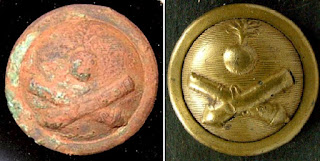In my DIV daily blogs, I told you about the experiences I had detecting in Virginia, and showed you some of the relics I recovered there. In this blog post, I'd like to take a closer look at some of those finds, and put them in the perspective of their use and historical significance. First, though, I'm happy to share with you the video I put together while on the trip. I wanted my friends, family, and readers to share in the excitement of the finds as they were made. I have both the bottle and plate reveals on camera, showing these rare items coming to light for the first time in 150 years. I do hope you enjoy it.
On June 9th, 1863, some 20,000 soldiers converged near the town of Brandy Station, Virginia. The ensuing battle was the largest cavalry engagement to ever take place in America. The Union cavalry launched a surprise raid against the Confederate cavalry encampment of Gen. Jeb Stuart. Although the attack failed to route the Confederates, and the outcome was not a significant victory for either side, the battle marked one important turning point in the war. For the first time, the Federal cavalry held their own against the Confederates, who had previously dominated in terms of mounted combat.
The properties we searched included part of the Brandy Station battlefield. In addition, the area was used as winter camps by both armies during the war. During the winter of 1863-1864, the Spillman Farm (site of DIV XXI) was home to the 1st Division, United States Cavalry. It was in the center of this camp that I recovered the sword belt buckle, worn by all enlisted cavalrymen. It is simply amazing to know that I walked the very hill these men are standing on in the picture. An enlarged section of the picture is also posted below, clearly showing the eagle sabre belt plates they wore, exactly like the one I recovered form the hillside. Numerous other cavalry-related items were recovered by other detectorists at the hunt, including bit bosses, rosettes, curb chains, bits, several sabre belt plates and carbine sling buckles, sharps and colt pistol bullets, 1st division hat numbers, a Co. K 1st Division ID tag, and even a bugle found at the bottom of a dug out hut. Below is a picture of Company K, 1st US Cavalry Division in that camp, not far from where my sabre belt plate was recovered.
The sword belt rig consisted of a leather belt with brass buckle, and a number of brass pieces for hanging the sword while standing and mounted. CivilWarMall has an excellent image which clearly illustrates the metal parts of the sword belt rig. Notice the large rivets and snap-swivel at the end of the hanging straps - these are the pieces of the sword belt rig found by Earl K. on the hillside near my Virginia buckle at DIV XIX, which he so graciously gave to me.
For a one-piece infantry belt, a small brass adjuster was attached to the opposite end of the belt from the buckle. You can see how it was used, and how it was affixed to the belt, in this example from Gatling-Gun.com. I recovered an infantry belt adjuster at a Union campsite located on the Beauregard Farm (DIV XX), which is also shown in the image below.
I also wanted to post a picture of the Ordnance button I recovered at a Confederate camp site on the Beauregard farm, with a non-dug example from relicman.com for comparison. The low-convex three-piece button was originally produced for a Union Ordnance Corp officer, responsible for the logistics of weapons development and procurement. The design features a flaming bomb over two crossed cannons, both of which bear the letters "US". This is a pre-war button was produced in the 1830's-40's, and a new design was used for Federal Ordnance Corp buttons in the 1850's-60's. It was found in a camp which produced several other confederate buttons, including North Carolina seal buttons and at least one Confederate Artillery "block A" button. The combination of the outdated style of the button as well as the location of the find makes it very likely that this button was re-purposed by the Confederacy for use by an artilleryman.






Excellent post Tony. Very informative - thanks for sharing.
ReplyDelete